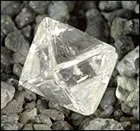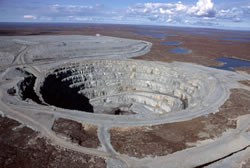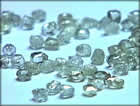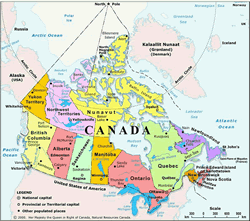There was the gold rush in the late-19th century in the Yukon when tens of thousands of stampeders headed north to Dawson City to make their fortunes. The rush is now for diamonds, first in the Northwest Territories and now in the new territory of Nunavut. This new territory is the result of Canada’s largest land claim settlement, created in 1999 to give the Inuit (Eskimo), representing 85% of its population, a greater voice in Canadian government. Occupying an area of 772,000 sq mi, or one-fifth of Canada’s landmass, it comprises the central and eastern parts of the former Northwest Territories, including Baffin and Ellesmere islands.
 For many years, the thought of finding diamonds in Canada was little more than a prospector’s dream. But that dream became a reality following the discovery of several world-class diamond-bearing deposits in Canada’s north. While only starting in 1991, Canada now ranks in the top three diamond producers in the world in terms of value.
For many years, the thought of finding diamonds in Canada was little more than a prospector’s dream. But that dream became a reality following the discovery of several world-class diamond-bearing deposits in Canada’s north. While only starting in 1991, Canada now ranks in the top three diamond producers in the world in terms of value.
Diamond exploration began in Canada as early as the 1960s but major kimberlite discoveries were not made until the 1980s. In 1991, the first economic diamond deposit was discovered in the Lac de Gras area of the Northwest Territories. Canada’s diamond industry has now become a $1.7 billion industry with all indicators pointing to potential for future growth. Canadian diamond production in 2002 was almost 5 million carats and in 2003 was 11.2 million carats.
Mines
 Canada became a diamond producer in October 1998 when the Ekati diamond mine opened about 300 kilometers northeast of Yellowknife. By April 1999, the mine had produced one million carats. Diamond exploration and exploitation are very expensive projects. The total investment for Ekati is estimated at $700 million U.S. including all project costs from the exploration to the start of the production. But the Ekati mine is expected to produce 3.5 to 4.5 million carats of rough diamonds per year, which are about 4% of the current global production by weight and 6% by value.
Canada became a diamond producer in October 1998 when the Ekati diamond mine opened about 300 kilometers northeast of Yellowknife. By April 1999, the mine had produced one million carats. Diamond exploration and exploitation are very expensive projects. The total investment for Ekati is estimated at $700 million U.S. including all project costs from the exploration to the start of the production. But the Ekati mine is expected to produce 3.5 to 4.5 million carats of rough diamonds per year, which are about 4% of the current global production by weight and 6% by value.
 At the Ekati Mine, mining kimberlite, ore and treating material activities are performed. Five separate kimberlite pipes (Panda, Koala, Fox, Sable and Misery) will be open pit mined and later, because of the higher value of their ore; underground mining will be done at Panda and Koala.
At the Ekati Mine, mining kimberlite, ore and treating material activities are performed. Five separate kimberlite pipes (Panda, Koala, Fox, Sable and Misery) will be open pit mined and later, because of the higher value of their ore; underground mining will be done at Panda and Koala.
Diavik, Canada’s second diamond mine, began production in January 2003. With its projected 20-year life, the average diamond production from this mine is expected to peak at six to eight million carats a year which is about 5% of the world’s total supply. Ekati’s average production over its projected 20-year life is expected to peak at three to five million carats a year, 4% of world production by volume.
A third diamond mine, Jericho-3, should begin production in 2005, in Nunavut. A fourth diamond mine, Snap Lake-4 in the Northwest Territories, should begin production in 2006.
Third-Largest Producer
 At the end of 2003, Canada was the world’s third-largest producer of diamonds, providing 15% of the world’s supply. The top two diamond producers are Botswana and Russia. Canada’s quest for diamonds looks like one of the biggest stories in Canada for the next 10 to 20 years and beyond.
At the end of 2003, Canada was the world’s third-largest producer of diamonds, providing 15% of the world’s supply. The top two diamond producers are Botswana and Russia. Canada’s quest for diamonds looks like one of the biggest stories in Canada for the next 10 to 20 years and beyond.
Between 1998 and 2002, 13.8 million carats have been mined and the diamonds are worth $2.8 billion. This is roughly a 1.5-kilogram bag of diamonds each day for five years, with each bag worth $1.5 million.
The supply of Canadian diamonds is not expected to diminish any time soon. Ekati, Diavik, Jericho and Snap Lake are expected to keep producing the best diamonds in the world for the next 18 years. By then, of course, judging by the prospecting, claims and permit action in the Canadian North, more diamond mines will have come on line, probably lots more.

